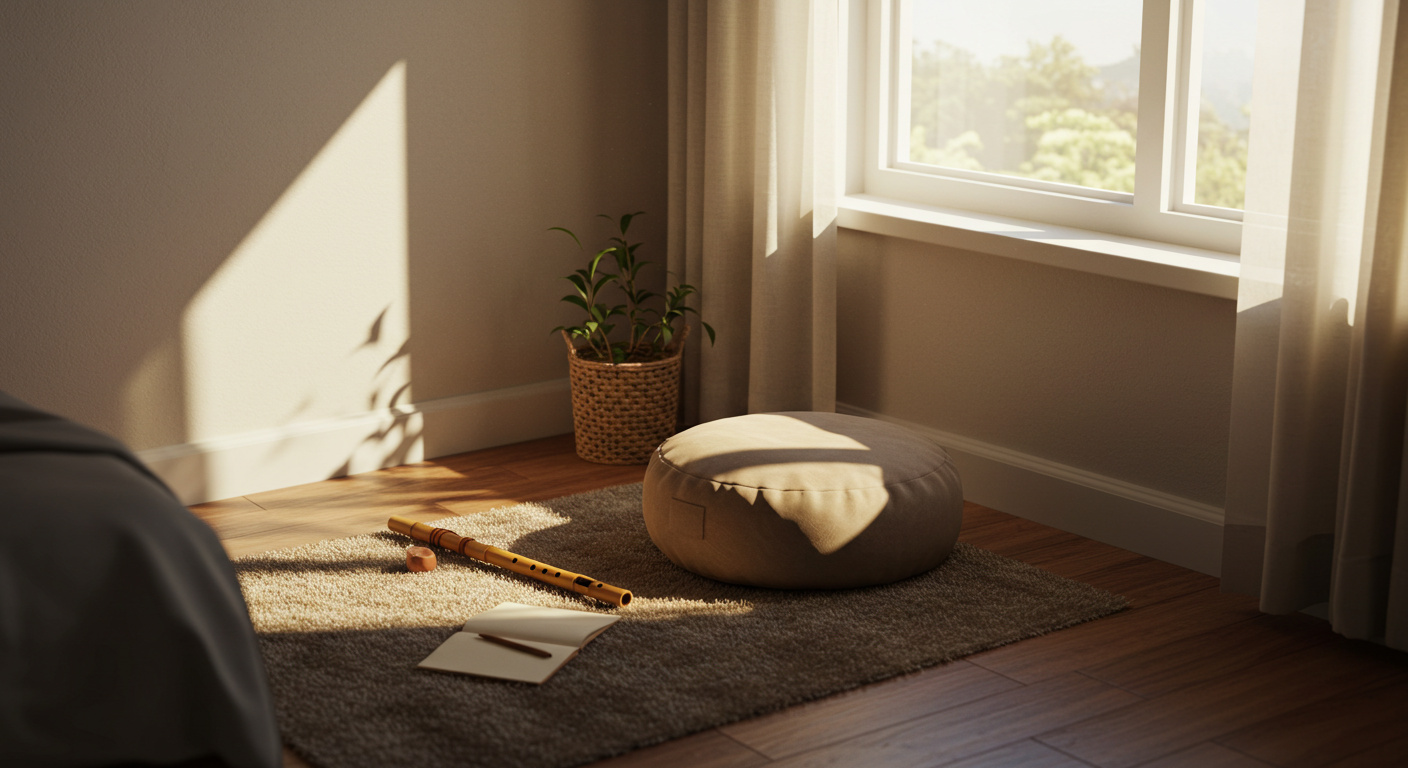Morning meditation has changed the way I approach each day. By practicing morning meditation with soothing bamboo flute music, I noticed immediate improvements in calmness, focus, and energy levels. Before this, I would wake up feeling rushed, anxious, and mentally cluttered. My morning routine often included checking emails, scrolling through messages, or worrying about tasks ahead. As a result, I started the day feeling exhausted before truly beginning. Integrating even a simple five-minute morning meditation practice created a noticeable shift. In this post, I’ll share my personal experiences, techniques that worked for me, and practical tips to help you incorporate morning meditation consistently.
Why Morning Meditation Matters
Calm the Mind Before the Day Begins
Starting the day with morning meditation sets the tone for mental clarity. In modern life, distractions abound: smartphones, social media, urgent emails, and noise can overwhelm our brains. I often found myself reacting to notifications before I even had a chance to think. Morning meditation allowed me to pause and center myself. By lying in bed or sitting comfortably, closing my eyes, and focusing on my breath, I experienced mental calm that persisted throughout the morning.
A study published in Frontiers in Psychology shows that even short meditative practices can reduce stress and improve cognitive control. Personally, I felt my brain shifting from scattered thoughts to a focused state within minutes. This initial calm made my morning tasks less stressful and more manageable.
Set the Tone for Focus and Productivity
The benefits extend beyond calmness. Morning meditation also prepares your brain for sustained focus. Previously, I would start work distracted, often switching between tasks ineffectively. Once I incorporated meditation, I noticed enhanced attention spans. Tasks became more manageable, and complex projects felt less daunting. Even brief sessions improved my ability to prioritize and tackle the most important tasks first.
Morning meditation acts like a mental reset button. It reduces reactive behaviors and increases intentional action. Over weeks, this translated into measurable productivity gains.
How to Practice Morning Meditation
Wake-Up Setup
Creating the right environment is essential. I place a small cushion or chair near my bed and dim the lights. A quiet environment encourages the mind to transition from sleep to focus. You don’t need a dedicated meditation room; even a corner of your bedroom works perfectly.
Personal tip: I keep my phone in “Do Not Disturb” mode and avoid checking notifications until after meditation. This prevents distractions and allows the brain to settle naturally.
Breathing & Awareness
Breath-focused meditation forms the core of my morning practice. Inhale slowly, hold for a moment, then exhale gently. Focus on each breath and notice the rising and falling of your chest or abdomen. Thoughts will come and go; acknowledge them without judgment and return your attention to the breath.
Visualizations can enhance this experience. I often imagine a calm lake reflecting the morning sky or visualize sunlight streaming into my room. Combining breath with visualization deepens relaxation and focus.
Incorporating Bamboo Flute Music
Music adds another layer of calm. Soft bamboo flute melodies, sometimes blended with piano or natural sounds, help the mind settle. The rhythmic flow guides breathing and strengthens focus. For beginners, I recommend YouTube tracks like Bamboo Flute Music for Morning Meditation, 10–20 minutes in length. Keep the volume low to avoid overstimulation.
Personally, I start with a 5-minute session. Gradually, I extend to 15–20 minutes as my practice deepens. The key is consistency, not duration. Even a few minutes every morning produces cumulative benefits.
Timing and Session Tips
Consistency Over Duration
I wake up 10 minutes earlier than usual to ensure I have uninterrupted meditation time. This consistency reinforces the habit. My brain begins to associate this time with calm and focus, signaling that the day starts intentionally.
Short Sessions Are Effective
Even 2–5 minutes can be highly effective, especially for beginners. I sometimes do micro-meditations during breaks if mornings are particularly rushed. Short sessions help maintain the routine and prevent mental fatigue. Over time, these micro-sessions naturally extend, reinforcing calm and focus.
Combine With Stretching or Gentle Movement
Adding light stretching after meditation amplifies the effect. A few yoga poses or gentle torso twists help release tension accumulated overnight. I usually combine three minutes of stretches with five minutes of meditation to start my day refreshed physically and mentally.
Personal Experience and Reflection
Observing Progress
Within a week of practicing daily morning meditation, I noticed reduced irritability and calmer mornings. Tasks that previously felt overwhelming became easier to manage. After a month, I experienced measurable improvements in focus and productivity. Morning meditation became a cornerstone of my daily routine, positively affecting both work and personal projects.
Reflection Journaling
I keep a small notebook beside my meditation space. After each session, I note thoughts, mood, and energy level. Journaling helps me track progress, observe patterns, and adjust techniques. For instance, I noticed my mind wandered more on days with insufficient sleep, allowing me to prioritize rest.
Sharing the Journey
Discussing meditation with friends or colleagues strengthens commitment. I share favorite flute tracks, breathing techniques, and session lengths. Feedback and shared experiences inspire adjustments that enhance practice. Community support is valuable for sustaining long-term habits.
Long-Term Benefits of Morning Meditation
Sustained Focus and Cognitive Clarity
Regular morning meditation trains attention control. I can prioritize tasks, complete work efficiently, and approach challenges with a clear mind.
Emotional Balance and Stress Reduction
Morning meditation activates the parasympathetic nervous system, lowering cortisol levels and stabilizing emotions. Over time, this leads to greater resilience in stressful situations.
Improved Sleep and Overall Well-Being
Interestingly, morning meditation improves sleep quality. Starting the day with calm awareness reduces mental clutter at night. Physically, meditation lowers resting heart rate and improves energy levels throughout the day.
Enhanced Creativity
I noticed creative insights often emerge immediately after meditation. The calm mental state encourages divergent thinking, helping solve problems and generate ideas effectively. Tasks that previously seemed uninspiring now feel more approachable.
Tips to Maximize Benefits
- Create a Dedicated Meditation Space – Even a small corner with a cushion and low light helps signal focus.
- Experiment With Music – Bamboo flute, piano, or gentle nature sounds can enhance relaxation.
- Combine Breath With Visualization – Picture calm landscapes to deepen meditation.
- Track Your Progress – Journaling post-session helps refine techniques.
- Stay Flexible – Adjust duration, position, and timing based on daily energy levels.
Your Experience and Community Engagement
Morning meditation is a personal journey. Some may prefer music-free sessions; others find it essential. I invite you to explore and comment on your experiences. What music, breathing techniques, or visualization strategies work best for you? Sharing insights builds a supportive community and reinforces habits.
Internal Link: → Sleep Meditation with Bamboo Flute Bliss
External Link: Morning meditation research






